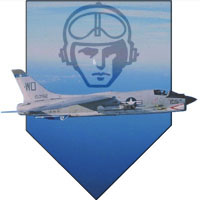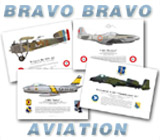|
Navigation
|
The F-8E(FN) Crusader
2. The F-8E(FN) Crusader in service 2.1 The Crusader in the Aéronavale In order to dispose of a nucleus of pilots qualified on the Crusader, four French pilots were sent to the USA in April 1963: LV Yves Goupil, LV Jean-Loup de la Fournière, EV Jean-Pierre Robillard and OE Robert Philippe. They were sent to VF-174 “Hell Razors” based at Cecil Field, FL., to qualify on the Crusader. Under the leadership of American pilots, notably Lts T. R. Schwartz, “Duke” Hernandez, Roger Brown and Joe Ruchala, they soloed on the F-8 on May 6. In April 1964, a second group followed, consisting of LV Dominique Lefebvre, Georges Imbert and Hervé le Pichon. The French pilots pilots made a good impression on their American masters. After some language problems were ironed out, the French proved their worth as pupils and pilots. John Nichols, one of the Landing Signal Officers who directed the group of French pilots thought them “magnificent, skilled pilots”. During carrier operations training, the French made an impressive run of 90 landings with no wave-off.
Although the Crusader had a rather high accident rate compared to contemporary fighters, it was considered as an agreeable airplane to fly but one that did not forgive mistakes during the approach phase. However, it was very popular with its pilots, who called it the Crouze and called themselves Crouzemen. One might notice that in the US also, the F-8 was a very popular aircraft. The first thirteen Crusaders were loaded on the Arromanches aircraft carrier in Norfolk, VA., on 6 October 1964 and arrived in Saint-Nazaire on 4 November. The 29 remaining aircraft were embarked on the Foch in early 1965. On 15 October 1964, the Flottille 12.F was reactivated on the Lann-Bihoué NAS in Britanny, under the command of LV Lefebvre. It was equipped with 12 Crusaders. On 1 March 1964, 14.F was reactivated, also at Lann-Bihoué, with LV Goupil as CO. The first carrier landing of a 12.F “Crouze” occured on 24 April 1965 on the Clémenceau. On July6, the first inflight refuelling was performed with an Etendard IVP. Flottile 12.F was declared operational on 1 March 1966. In 1968, both Flottille moved to Landivisiau NAS. In October 1974 on the Clémenceau and later in April 1977 on the Foch, the Crusaders operated over Djibouti in the Saphir missions. On 7 May 1977, two Crusaders on a training missions were expected to engage two F-100 Super Sabres from the Djibouti-based 4/11 Jura squadron. After the leader spotted the “enemy” and engaged into mock combat, he realized his opponents were not French F-100's as expected but MiG-21's from Yemen. His wingman joined the fighting and weapons were armed but the fight ended without a shot being fired. This was presumably the only wartime interception by French Crusaders. On 17 April 1979, the Crusaders from 14.F were written off and the unit converted to the Dassault Super Etendard. In 14 years of time, Crusaders from 14.F flew 45 472 hours and made 6 800 deck landings. From now on, only Flottille 12.F would operate the Crusader. On 7 September 1982, six F-8E(FN) boarded the Foch during operations Olifant IV near the coast of Lebanon. They returned for operation Olifant XVII on 2 September 1983 and Olifant XX on 25 January 1984. On 17 October 1984, the “Crouze” operated from the Foch near the coasts of Libya. Operation Mirmillon was destined to give a demonstration of power and calm Colonel Khaddafi down.
On 30 July 1987, aircraft from 12.F were sent to the Arabian Sea on board the Clémenceau. Operation Prométhée was meant to ensure free navigation in the Persian Gulf, where Iranian speedboats regularly attacked ships. According to some sources, French Crusaders made several interceptions of Iranian aircraft, but never entered combat. Mock combat did occur while the Clémenceau was in the Persian Gulf: a lone Crusader (n°37) engaged a pair of US Navy VF-154 F-14 Tomcats. Although the Crusader pilot lost the engagement, the Navy pilots reckoned they had difficulties coping with their opponent's skilled and tactically imaginative flying. In August 1989, the Crusader operated from the Foch off the Lebanese coast to support a humanitarian mission. Starting in 1993, detachments of the 12.F were regularly sent off the coast of Yugoslavia during operation Balbuzard.The last French Crusader wartime missions happened between February and June 1999 from the Foch, cruising in the Adriatic sea for opetation Trident over Kosovo. In 1999, the Crusader finally went into retirement. On 28 October 1999 at 12:45 PM, LV Denis made the last carrier landing with n°34 on the Foch. The last launch occurred later that day when CF Guillot catapulted n°11, which had received a special livery for the event. A large number of American Crusader pilots were present for the ceremony held for the departure of what was the sole French Navy interceptor for a period of 35 years.
2.1 Colours & markings Please note that these notes on the Crusader's colours & markings are based on a limited number of documents, and therefore are not to be considered as an absolute reference. Please help me improve these by emailing me your suggestions or corrections.
The first F-8 Crusader received by the French Navy in November 1964 were quite similar to those operated by the US Navy: Light Gull Grey with Insignia White undersurfaces and mobile parts. A large French roundel with an anchor and a yellow border was located between the wings and tail assembly on both sides of the fuselage. This Aéronavale insignia was also carried on the port wing uppersurface and the starboard wing undersurface. The unit's badge was generally painted on both sides of the cockpit. The aircraft's tactical number was painted in black on the fin and on both fuselage sides behind the cockpit. The number is also repeated on the starboard wing uppersurface. The radome and forward canopy are also painted black. The fin's leading edge is painted dark grey. Stenciling is identical to that of USN aircraft.
A variation of this initial camouflage was later introduced, probably in the early 1980s: the F-8 Crusaders were painted entirely grey, in a lighter tone than Light Gull Grey. The word “MARINE” (NAVY) was painted black above the horizontal stabilizer. Stenciling was now written in French, while the numbers and roundels remained unchanged.
The last paint scheme worn by the French Crusaders appeared in the early 1990s. They were painted in a dark grey-blue colour reminiscent of the PRU Blue used on World War II RAF reconnaissance aircraft. The tactical numbers and « MARINE » word were painted light grey. The roundel lost its yellow border and its size was significantly reduced. Stenciling also evolved substantially and was more present than previously was the case.
<< Return to Part 1 : Origins and development of the F-8E(FN) Crusader
|
||||






